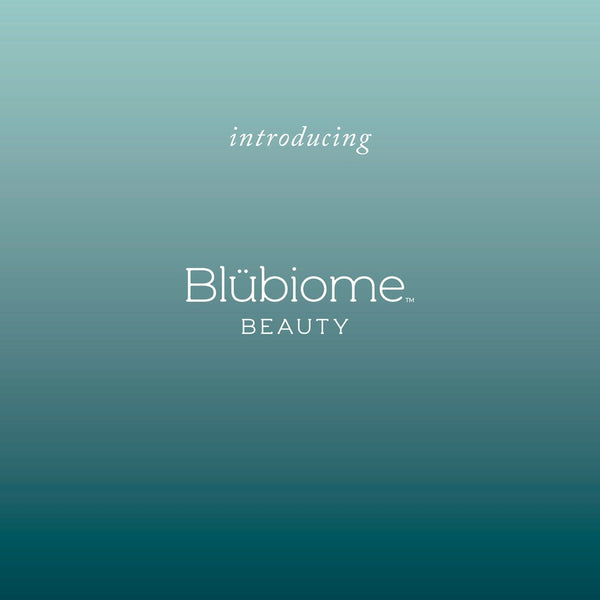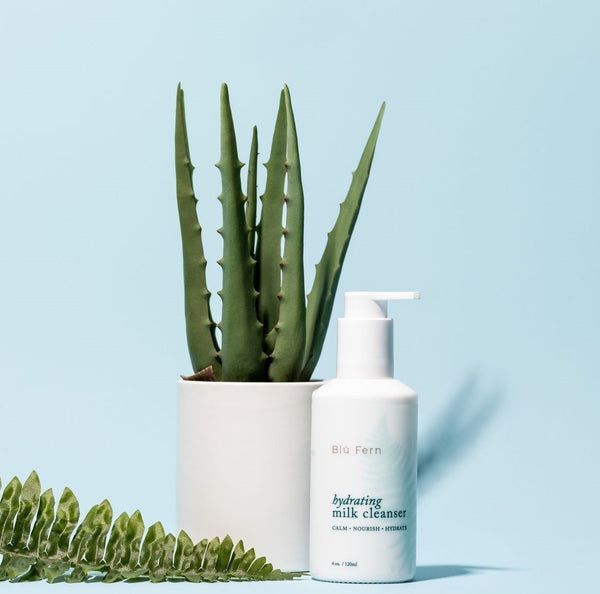Skincare routines have been made complicated with the increased focus on layering, and use of multiple skin actives. This can be a bit confusing. This article will take you back to basics and lay out the three essential principles of good skincare.
Step one: Hydrate
Hydrating and moisturizing are not the same thing. It’s important to know this distinction before we get started: those two words are not interchangeable.
Hydrating is putting water into your body, while moisturizing helps seal that water in. You can make a cup out of clay, but it won’t be strong and useful until you’ve fired it in a kiln. The same goes with hydrating and moisturizing; you need them both to have truly healthy skin.
Now that the vocabulary lesson is over, let’s talk about 7 different ways to hydrate your skin.
Drink Water
This seems like a no-brainer, and yet...have you had enough water today? The human body is about 75% water, and we need it to help keep our bodies running. Because we lose water throughout the day, we must keep hydrated by replacing the fluids we lost.
While we’re all used to the parameters of 8 cups a day, newer studies have shown that different people need different amounts of water per day, and 8 cups for one person may be too little or too much.
According to the Mayo Clinic, men should drink about 15.5 cups of fluids a day, and women should drink about 11.5. Why do men need more water? Typically, men have a higher percentage of water weight and less body fat. On average, 60% of a man’s weight is water, and it’s around 55% for women.
However, if you feel thirsty, no matter how much or how little water you’ve had to drink, it’s your body’s way of telling you you’re in a dehydration danger zone. Your body has an excellent water management system and knows where to deliver water to the parts of the body that need it most, but when it’s running low, you’ll start to feel dizzy, nauseous, and tired.
Staying hydrated improves your skin because it increases your skin’s elasticity and reduces the looks of fine lines and wrinkles. Dehydrated skin produces more oil to balance out the dryness, so staying hydrated also keeps your oil levels normal, preventing acne and inflammation.
So, keep sipping throughout the day!
Get a Humidifier
In another blog, we briefly extolled the virtues of humidifiers but let’s add some more detail as to why getting a humidifier for your home can help your skin (and your plants!).
Humidifiers work by emitting water vapor or steam into the air, putting moisture into the air in your home. While having a bit of humidity in your home can help keep your skin from drying out, it also has a few other benefits:
- Reduce the spread of germs: While this is not the only measure you should take to reduce germs spread in your home, some studies show that germs like drier air more and can survive longer in it.
- Relieve allergy and asthma symptoms: By keeping the air in your home moist, you can reduce your nose and throat’s dryness and inflammation. When you reduce the inflammation, it’s easier for your body to get rid of allergens and other irritants.
- Reduce snoring: Moisture in the air can relieve nasal congestions, which can help reduce snoring.
- Make plants happy: Extra moisture in the air helps keep your plants soil, stems and leave them hydrated and thriving.
- Help your furry friends feel more comfortable: Just like humans, our pets get dry, itchy, and inflamed during cold weather. A humidifier has the same benefits for your fur babies as they do for you and your plants.
Humidifiers are G R E A T but be sure to take care of them as neglecting your humidifier or misusing it can cause issues and health hazards.
Get to Love Sheet Masks
You’ve probably seen them on social media at some point, a person with a sheet mask enjoying a little Me Time. Sheet masks got popular in Korea and made their way to the US a few years ago. You can now find them in grocery stores, pharmacies, and beauty stores.
Not every sheet mask is created equally, so be sure to use a mask from a brand you trust, read the ingredients list, and use as directed. They can be a lovely, quick, hydrating pick me up that can benefit your skin in various ways, from brightening to tightening to hydrating to calming.
Have a skin issue? Yeah, there’s probably a sheet mask for that. Bonus? Some of them have designs on them like animal faces because it’s important not to take yourself too seriously.
Step Two: Moisturize
Oil cleansers and facial oils are great for all skin types and can help create, maintain, and seal in your natural hydration, creating a moisture barrier that keeps your skin from drying out and gives it a little extra glow.
Using an oil cleanser helps remove dead skin cells, make-up, and product residue on your face from the day, so when you use your hydrating cleanser, it has a cleaner canvas to work with and makes it easier to hydrate your skin.
Eat More (Healthy) Fats
With the weather both cold and dry, it’s imperative to find healthy, safe ways to keep yourself hydrated and moisturized. There are several fatty but healthy foods you can incorporate into your diet that will help keep your skin moisturized, many of which you may already be eating!
- Fatty fish like salmon, herring, and mackerel.
Omega-3 Fatty Acids: These fatty fish contain omega-3 fatty acids, which help keep skin thick and moisturized as well as reducing inflammation, and your skin’s sensitivity to UV light.
Vitamin E: This vitamin is necessary as it’s an important antioxidant for your skin. It helps soothe inflammation, strengthens skin, and protects against free radicals, which can break down skin’s collagen and create fine lines, saggy skin, dark spots, and acne.
Zinc: Not thought of as much as Vitamin E and Omega-3, Zinc helps protect skin from inflammation and promotes the production of new skin cells, which helps improve overall skin health and can speed up the healing process. - Avocados
Yes, this is a good fat we’re used to ingesting normally, but do you know why Avocados are good for your skin? They’re actually little powerhouses!
Vitamin E: An antioxidant that strengthens, soothes inflammation, and helps protect against UV rays.
Vitamin C: Move over, oranges! Avocados are a vitamin c powerhouse, too! Vitamin C helps create collagen, which helps keep your skin strong and healthy. It’s also an antioxidant, which helps prevent fine lines, dark spots, wrinkles, and sagginess. - Nuts and Seeds
Most nuts and seeds contain vitamin E, selenium, zinc, and protein, all things that promote healthier skin.
Selenium: Selenium is great at neutralizing free radicals that damage the skin. It’s very similar in property to Vitamin E.
Protein: Protein contains amino acids and collagen, essential for building stronger, more elastic skin.
Exfoliate (Gently)
For your moisturizing techniques to work, dead skin cells need to be exfoliated to let the new skin breathe, take product, and moisturize. With this in mind, it’s good to gently buff your skin at least 2-3 times a week. If you have sensitive or oily skin, you may want to do only 1-2 times a week as over-exfoliation can cause the over-production of oils in the skin, leading to acne and other inflammation.
This is the same for the rest of your body, not just your face! Regular exfoliation of your arms, legs, back, etc., means an all-over glow and less itchiness and dryness as the winter progresses.
Switch to Oils and Creams
Facial oils not only help remove makeup, product build-up, and dead skin, but they also help moisturize your skin and strengthen the natural moisture seal that keeps the moisture in!
Facial oils work for all skin types and are typically better for you as they contain more natural ingredients, which means fewer harsh chemicals.
If your skin is dehydrated, you may want to try a heavy-duty night cream as well as a thicker moisturizer for the day.
Step Three: Protect
At some points in time, sun worship was the order of the day and for many of us, our desire to be active outdoors can seem incompatible with our desire to protect our skin from the sun.
How does the Sun damage my skin?
Ultraviolet radiation, or UV light, actually damages your skin and changes it at the cellular level. UV light can damage your skin from the epidermis (the surface level) all of the ways to the deepest level, the dermis.
This type of damage not only can visibly mar your skin, but it can also cause things like skin cancer and premature aging of the skin.
UV Protection Tips
- We’ll start with the most obvious! While SPF 30 is often cited as an acceptable amount of protection, some brands offer SPF 100+. Whatever level of protection you choose, make sure it’s a broad spectrum, so it covers you from both UVA and UVB rays.
What you may not know is that there are some pretty specific instructions for applying sunscreen that will provide you with the most significant benefit:
Apply 20 minutes before you go outside. The sunscreen needs time to uniformly dry all over your skin to provide the best protection. As it dries, it evaporates, leaving a thin layer of UV filters on your skin. The drying process is essential because the sunscreen needs time to dry before you’re off and walking, swimming, running, etc.
Measure in teaspoons. The amount of sunscreen you also use matters: use too much, and it won’t dry in a reasonable amount of time, use too little, and you don’t get the right amount of coverage. The general rule for the amount of sunscreen you should apply dictates a teaspoon in the following areas: each of your arms, each of your legs, the front of your body, and the back of your body.
Reapply! Sunscreen is not a set it and forget it measure. Event “Active” or “Sports” brands require reapplication. Even if your sunscreen is water-resistant, reapply every 40 minutes.
And remember: you can still get UV damage on a cloudy day!
- You’ve probably heard this before but wearing long sleeves, pants, and a sunhat can help reduce your skin’s exposure to UV rays. However, if you live in a part of the world where the summer heat doesn’t allow for long sleeves, pants, and layers, you may feel like this is not an option for you.
There are brands like Athleta, UNIQLO, and Lulu Lemon that make lightweight clothes with built-in UV protection. It may be worth checking it out and testing it in lighter, Spring weather so you can decide for yourself if it will work for you in hotter temperatures. - The shade is your friend. An umbrella, a tree, a hat, and sunglasses; anything you can do to provide relief from the sun, even temporarily, will help reduce sun damage.
- Don’t tan. This can seem challenging, everyone loves a good, bronzy glow in the Spring and summer, but even indoor tanning beds can increase your chances of getting skin cancer and skin damage. Instead, get your golden glow through the use of non-toxic self-tanners.
Protective Skincare: Blue Light Damage
We know that blue light can affect our vision and our brain’s ability to prep for sleep, but did you know that blue light also causes skin damage? There’s confusion around this topic because some dermatological treatments use blue light to heal damaged skin and acne.
So what’s the deal?
How does blue light damage my skin?
Blue light does have healing effects when applied by a dermatologist or an esthetician, but these are typically tools used for skin care treatment, and exposure is limited.
When we are exposed to blue light from electronic devices like our computers and smartphones, it’s a different story because we’re exposing our skin, especially our sensitive facial skin, to the light for hours at a time, every day, or almost every day.
This long exposure can generate free radicals and break down the collagen in your skin leading to spots, premature wrinkles, and drooping.
Blue Light Protection Tips
It’s essential to do your research on any product that claims to protect your skin and eyes, specifically from blue light, as there are many fake products out there. There are two proven ways that not only help you with blue light but help your skin in general:
- Mineral sunscreen with Zinc Oxide. Zinc oxide, a common ingredient in sunscreen, not only protects against UVA and UVB rays. But it’s also been shown to protect from blue light damage, as well. If there’s only one skincare tip you take away from this post: you can’t go wrong with sunscreen every day, whether you’re outdoors or indoors.
- Matcha Green Tea. Matcha green tea is not only a popular tea that is relatively easy to get; it’s an antioxidant powerhouse that can help fight the free radicals generated by blue lights. Other foods have antioxidant powers in them, so be sure to look around and see what works within your routine so you’re more likely to eat/drink it during the day.
The three steps to maintaining healthy skin are the absolute basics that, if done correctly, you can reveal that healthy glow that many strive for. These strategies are helpful for all skin types and ages. Additional steps would generally be targeted to specific skin concerns such as acne or pigmentation. More to come on those topics.
 Skip to content
Skip to content




